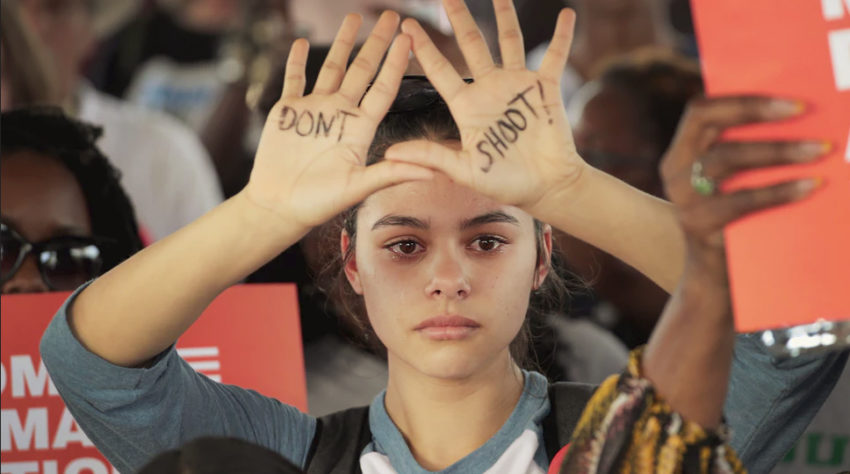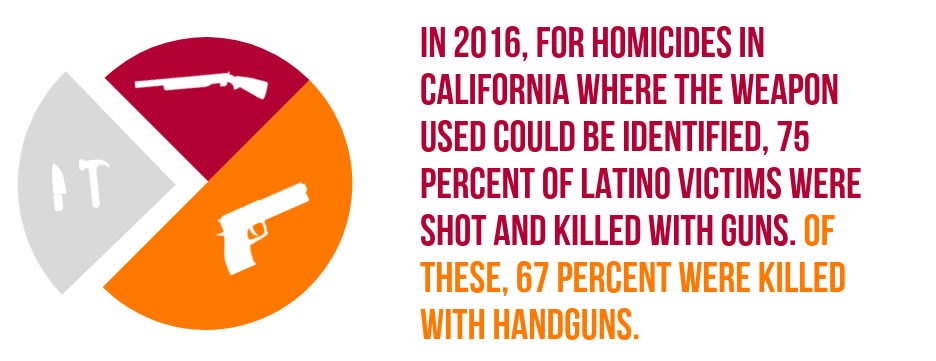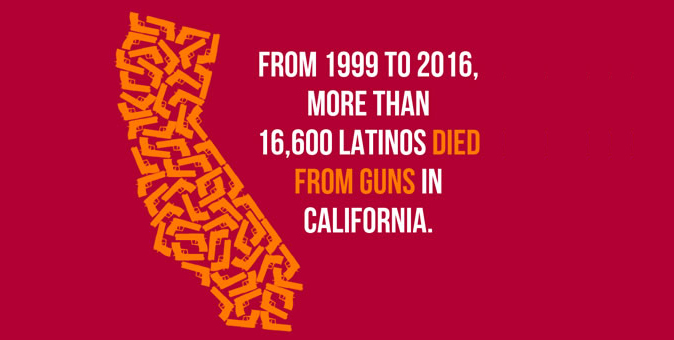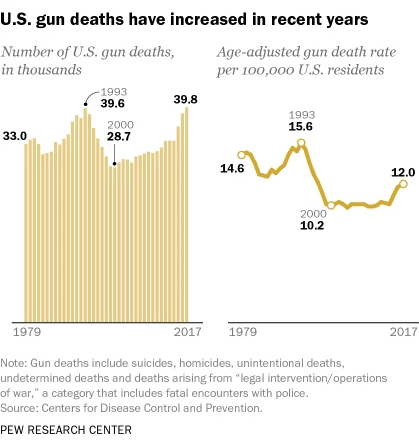
Share On Social!
Nearly 17,000 Latinos were killed with guns in California from 1999 through 2016, which mirrors a national rise in gun violence, according to a new study from the Violence Policy Center.
But the alarming data doesn’t end there.
In 2016, Latino firearm homicide victimization rate was 4.40 per 100,000. That is more than three times the white firearm homicide victimization rate of 1.45 per 100,000.
The firearm homicide victimization rate jumps to 6.63 per 100,000 for Latinos ages 10-24.
“For far too long, we have not had actionable data on Latino gun violence in California,” said Fernando Rejón of the Urban Peace Institute. “This [Violence Policy Center] report provides us with critical information to understand the impacts and make change.”
California’s Shocking Gun Violence Rates

The Violence Policy Center’s study examined CDC and California Department of Justice data to identify disparities in lethal gun violence.
Among the study’s findings:
- From 1999 to 2016, more than 16,600 Latinos died from guns in California. That includes: 12,912 in firearm homicides, 3,402 in firearm suicides, and 319 in unintentional firearm deaths. 45% (7,485) of the victims were ages 10-24.
- From 1999 to 2016, 74% of all Latino homicide victims died by firearm.
- In 2016, 921 Latinos died by firearms in California in homicides, suicides, and unintentional deaths. More than a third (322) of the victims were ages 10-24.
- In 2016, 91 percent% of Latina victims (70 out of 77) were murdered by someone they knew. Nearly half of them died by firearms.

The study makes the case for more data to offer a more complete picture of the full impact of gun death and injury, and aid violence-prevention efforts.
“Because of limitations in data collection, the true scale of the impact of gun violence on Hispanic men, women, boys, and girls in California is not fully known,” the report concludes.
“Comprehensive, consistent, and reliable information from a broad range of sources is necessary to ensure that violence prevention policies work to save lives, protect families, and ensure healthy communities. This is true not only for Hispanics in California, but for all residents of the state.”
National Data: Gun Violence and Race/Ethnicity
2017 saw more gun deaths in the U.S. than any year in decades, according to CDC data.
 The nearly 40,000 Americans who died of gun-related injuries in 2017 marked a 19% increase from 2012. It also is the highest annual total since 1993.
The nearly 40,000 Americans who died of gun-related injuries in 2017 marked a 19% increase from 2012. It also is the highest annual total since 1993.
“The increase in gun deaths over five years included a 15% rise in suicides involving a gun and a 25% rise in murders involving a firearm,” Pew Research Center reports.
Here are more key national data points from Pew Research Center:
- Three-in-ten American adults (30%) say they personally own a gun. An additional 11% say they live with someone who does, according to a 2017 Pew Research Center survey.
- Two-thirds of gun owners (67%) say protection is the major reason why they own a firearm.
- Nearly half of Americans (44%) say they know someone who has been shot. Most black adults (57%) say this, compared with 43% of whites and 42% of Latinos.
- Separately, 32% of blacks and 24% of Latinos say someone has used a gun to threaten or intimidate them or someone in their family. Only 20% of whites say the same, according to the 2017 survey.
National Data: Gun Violence Policies
 Most Americans appear to want stricter gun laws.
Most Americans appear to want stricter gun laws.
About 57% of U.S. adults (57%) say gun laws should be more strict. A smaller share say laws are about right (31%) or should be less strict (11%), according to a 2018 Pew Research Center poll.
These views differ sharply by party, as expected.
About 80% of Democrats say gun laws should be stricter, while 28% of Republicans say the same.
The parties do agree on some things, though.
“They agree on preventing those with mental illnesses and those on federal watch lists from buying guns,” according to Pew Research Center. “Among gun owners, there is a diversity of views on gun policy, driven in large part by party affiliation.”
Americans are split over whether legal changes would lead to fewer mass shootings, according to 2018 poll.
Americans are also split on a related question about the potential impact that more Americans owning guns would have on crime more broadly.
“While 37% of U.S. adults say there would be more crime if more Americans owned guns, 33% say there would be no difference and 29% say there would be less crime,” according to the poll.
Addressing Gun Violence in California
In California, gun violence is an ongoing crisis for young Latinos, said Josh Sugarmann of the Violence Policy Center in a press release.
Progress is happening to reduce gun violence and gather data needed to better understand its many impacts.
But Sugarmann said they need more, better data.
This includes improved data quality, access, and inclusion of racial/ethnic data and analyses.
“To ensure that progress continues to be made, Californians working to reduce violence in their communities need the best information available, not only to better understand the issues they’re facing, but also identify the most effective violence prevention strategies,” he said.
Civic activism is rising, too.
In 2018, TOMS pledged $5 million to gun violence prevention organizations, and also announced its plan to promote civic activism among its customers, Bustle reports. Here is a February 2019 update on the group’s #EndGunViolenceTogether campaign.
Help us seek solutions at our #SaludTues Tweetchat on Twitter on Tuesday, March 12, 2019, to help create a new narrative on preventing gun violence in Latino and all communities.
Learn more ways to create healthy, cohesive communities!
Editor’s Note: Main photo by Scott Olson/Getty Images News/Getty Images via Bustle.
Explore More:
Overcoming Harmful BiasesBy The Numbers
3
Big Excuses
people use to justify discriminatory behavior



